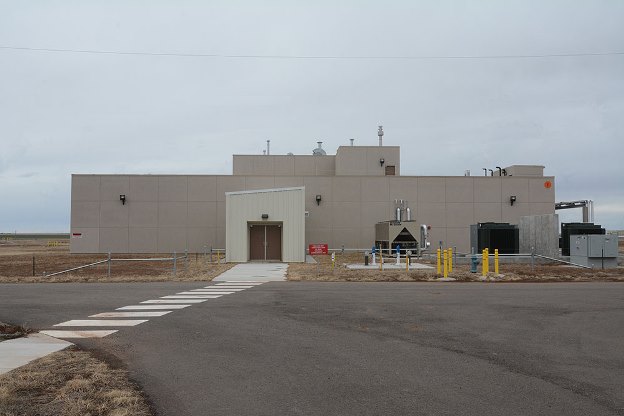Pantex Blog
Pantex Hiring Event A Success
Consolidated Nuclear Security, LLC (CNS) managing and operating contractor of Pantex, held a hiring event Aug. 8 at the Amarillo College Business and Industry Center. Thanks to partnerships with the Texas Workforce Solutions Panhandle and Amarillo College, the first‑of‑its‑kind hiring event for Pantex was a success.
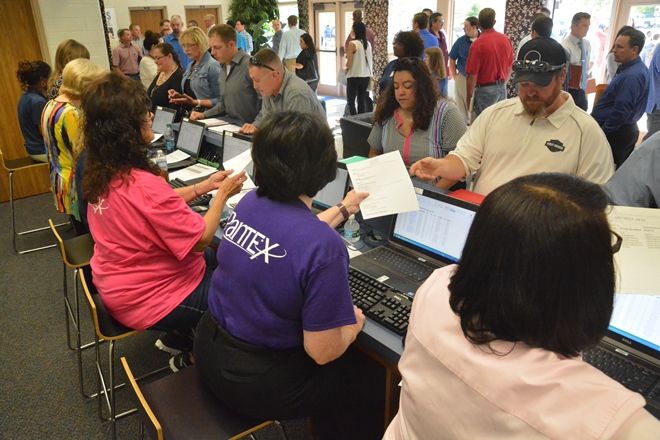
Workforce Solutions Panhandle helped spread the word through social media that Pantex was looking to fill more than 100 open positions. Would be job‑seekers from as far away as Florida and Arizona made their way to Amarillo for the chance of landing a job at Pantex.
Hiring managers screened and interviewed candidates for jobs in accounting, engineering, emergency management, information technology, maintenance, medical, production, quality, radiation safety, supply chain and utilities.
CNS Director of Workforce Strategies Heather Freeman said they were very pleased with the turnout, with potential employees lining up in droves for a Pantex job.
“The event was a success because we were able to meet and interview so many local, regional and out‑of‑state candidates. Hiring managers conducted about 175 interviews on‑the‑spot,” she said. These new jobs would add to the 3,100 people the Plant already employs.
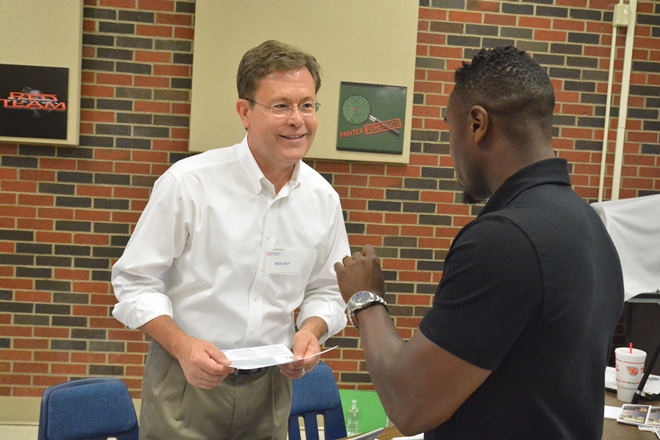
Job offers have already been extended and accepted for several positions. In fact, the majority of offers are expected to be sent out within the next two weeks.
“We were very pleased with the response to the event and expect to make offers over the next two weeks from candidates we interviewed at the event. Additionally, we have begun scheduling on‑site interviews for candidates we met at the event, but were not able to interview that day,” added Freeman.
Plans for future hiring events haven’t been finalized yet, but with the amount of interest shown at the initial offering, organizers will consider holding more of these events to find qualified candidates to help carry out the important Pantex mission.
“We will definitely consider doing like events in the future,” Freeman said.

CNS names Guess Director of Nuclear Safety Oversight
Ken Guess recently joined Consolidated Nuclear Security, LLC as the director of Nuclear Safety Oversight. A 25-year submarine officer in the U.S. Nuclear Navy, Guess’ most recent position was as Power Ascension Test Director in the Operational Readiness department for the Tennessee Valley Authority’s Watts Bar Nuclear Unit 2.
“I’m excited to be starting a second career here,” Guess said. “Organizations that have aging infrastructures like Y-12 and Pantex have challenges. My goal is to continue the focus on the mission, ensuring we’re all doing the best job we can for the security of our country.”
Bill Heineken, director of Nuclear Operations Support, said, “I enjoyed that Ken has been an end user of both Pantex and Y-12 products. While in charge of those products, he had complete confidence in their quality and efficacy.”
Guess said, “As a strategic weapons officer on a missile submarine, we were ready to execute. I never even remotely doubted that the weapons systems would work as advertised.”
Heineken said, “Ken’s role is to integrate and execute the nuclear safety role and conduct of operations at the enterprise level. In searching for someone to hold this role, we wanted to make sure we had the right person to meet this challenge.”
Guess earned his bachelor of science and master’s degrees in electrical engineering from the University of Tennessee, Knoxville, and the University of Houston, respectively. He also earned technical nuclear power certifications from the Navy Nuclear Power School and Nuclear Propulsion Training Unit.
Pantex and Y-12 piloting BUILDER as Centers of Excellence
Pantex, Y-12 and Lawrence Livermore National Laboratory recently completed the first phase of a software program pilot, designated as BUILDER Centers of Excellence by the National Nuclear Security Administration.
The three sites were chosen by NNSA in 2013 to pilot the program that helps facility managers and maintenance managers decide how best to maintain building infrastructure. The first phase was completed this spring and phase two should be completed this fall.
The BUILDER Sustainment Management System was developed by the U.S. Army Corps of Engineers to aid the U.S. Army in managing its 160,000 buildings. The goal of BUILDER is to equip building managers to proactively respond to infrastructure maintenance needs and thus reduce the chance of unexpected component breakdowns and system failures. The Department of Defense adopted the BUILDER program, and it’s also being used by the U.S. Marine Corps and Navy.
NNSA plans to roll out BUILDER to all its sites where the critical nature of the national security work makes preventing facility system failures and breakdowns imperative.
“Everything in a building has an estimated life. BUILDER allows us to track when components were last replaced and know when they will need to be replaced again,” Y12 Site Master Planner Jane Nations said. “This effort will greatly improve NNSA’s ability to more accurately determine maintenance and recapitalization costs across the complex, and improve how NNSA prioritizes all of the facilities as a whole.”
Nations said CNS was chosen as a pilot because of the willingness of its team members in Program Integration and Infrastructure to test and implement new initiatives.
CNS completed the first phase of implementation, which entailed inputting data for mission critical facilities in March of this year. Phase two will be completed this fall, fully populating the system with all buildings in the inventory. Once this is completed, condition and functionality assessments will be performed and data entered. The goal by 2018 is to complete data loading on the total 345 facilities at Y12 as well as 620 at Pantex, then implementing the program to plan maintenance and repair projects.
Ultimately facility managers and maintenance mangers will use the BUILDER program to measure maintenance investment and condition index at facilities across all eight NNSA sites.
The Phase 1 and 2 process included the development of property data (e.g., year built, square footage, master equipment list and construction materials). More detailed information will be hand gathered such as system inventories and condition inspection results to complete the information for each facility record.
Pantex’s Steve Patterson, Infrastructure Facilities Services, said he and his team members are proud to work alongside their Y12 colleagues to assist NNSA with the implementation of BUILDER. He anticipates the program will allow for cleaner, leaner and more accurate data.
“With most sites facing limited resources and funding, accurate asset management information plays a critical role in property lifecycle management, maintenance budgeting, program missions and sustainment,” Patterson said. “Pantex is already seeing great potential with BUILDER.”
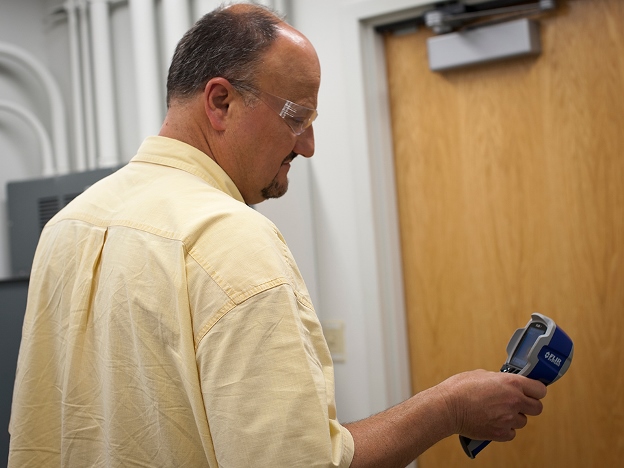
Electrical inspector Ken Miller demonstrates how a thermal imager is used during facility condition assessments, which provide data for the BUILDER Sustainment Management System.
Day in the Life of a Pit
With underground testing long out of the question, the health of the country’s nuclear weapons stockpile relies in part on pit testing conducted at Pantex. At Pantex’s Special Nuclear Material Component Requalification Facility, pits — a nuclear weapon’s heart — are probed for analytical data.
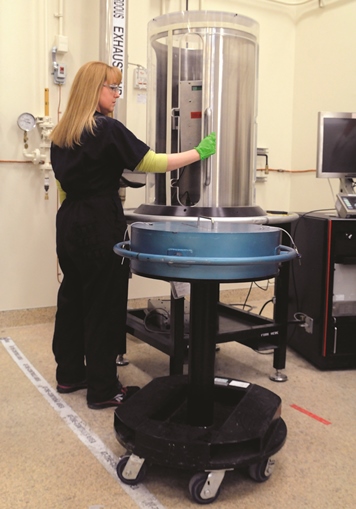 “When we obtain a pit, it is unpackaged, cleaned, visually inspected and weighed, and a leak check is performed to ensure it’s sealed,” Special Nuclear Materials Department Manager Randall Hodges said. “That’s when it goes to either the Laser Gas Sampling System for surveillance or the integrated pumpdown and fill station for requalification.”
“When we obtain a pit, it is unpackaged, cleaned, visually inspected and weighed, and a leak check is performed to ensure it’s sealed,” Special Nuclear Materials Department Manager Randall Hodges said. “That’s when it goes to either the Laser Gas Sampling System for surveillance or the integrated pumpdown and fill station for requalification.”
Akin to a blood draw, the Laser Gas Sampling System enlists a laser to drill a hole into the pit tube the diameter of a human hair to obtain a small amount of gas. The same laser welds the hole shut, and the gas sample is transported to the gas lab where a determination is made about its composition.
A second process is comparable to a blood transfusion. The integrated pumpdown and fill station’s high‑energy laser drills a hole in the pit tube, the gas is replaced, and the laser welds the hole shut. These gas samples also head to the gas lab for analysis.
Both systems support the overall Pantex mission. Requalification allows a pit to stay in the stockpile; surveillance involves obtaining information on a pit, then sharing it with the national laboratories to help certify to the President that the nuclear weapons stockpile is at an extremely high level of quality.
“Our most important work involves the surveillance and reprocessing of nuclear material for nuclear weapons,” David Cole, Weapons Operations director, said. “It has to be very high quality given the lack of underground testing. We can’t build new, so we’ve got to take components that were not designed to remain in the stockpile this long and make them last longer.”
A pit’s visit to the Special Nuclear Material Component Requalification Facility involves much more than “blood work,” and the entire process can take four to five days. Microfocus X‑ray ensures that the pit’s weld is acceptable. Then, it revisits both the weigh station and leak test station.
Additional steps include the dye penetrant station, coordinate measuring machine and Tube Evaluation Test System. The pit is then re‑marked and its condition documented at the pit imaging station. Finally, it is repackaged and sent back to the warehouse for future use in another weapon.
A second Laser Gas Sampling System, referred to as LGS2, will soon double Pantex’s operational capacity, increase reliability and provide higher quality and more consistent welds.
“The laser in LGS2 is a newer technology system that runs off laser diodes rather than flash lamps, and produces more consistent operation as it ages,” Nate Davis, former Special Nuclear Materials Technical Department manager, said. “It also allows the use of fiber transmission of the laser rather than a complicated mechanical/optical train, which alleviates maintenance time involved in aligning the optics.”
A second requalification process, to be designed in house, is expected to be installed at the end of fiscal 2016.
Hub of the High Explosives Center of Excellence
The Pantex Plant manufactures high explosives to support the nation’s nuclear deterrent. Nuclear weapons require both high‑explosive charges and special nuclear material. Pantex’s experts manufacture the main‑charge high explosive by making the raw munitions powder, heating it in ovens and pressing it into a solid. The main‑charge high explosive surrounds the nuclear core, or pit, of a weapon.
For more than 50 years, the Pantex Plant has manufactured high‑explosive charges for every weapon in the nation’s nuclear stockpile. Much of that work is carried out in six aging facilities. But soon, high‑explosive operations will be conducted in the site’s newly built High Explosives Pressing Facility. The one‑of‑a‑kind HEPF will consolidate processes in a single modern facility, increase manufacturing throughput by 180 percent, and over the life of the facility, save $92 million in high‑explosive transportation costs.
For Lennon Mings, HEPF represents a quantum leap in high‑explosives operations. “This is a huge advancement,” said Mings, a high‑explosives pressing engineer. “While Pantex has always been at the forefront of pressing operations, HEPF will allow us to increase not only productivity but also our capability both in the size of explosive components and in improved process control, which equates to a better quality product.”
|
|
Mings and other Pantex engineers and technicians helped design the processes in the new facility so that equipment and tools are within easy reach, which drives efficiency, nearly doubles throughput without adding personnel and increases worker protection. Moreover, detailed information in the design model will aid in machine maintenance and repair.
Not surprisingly, the new facility will change how Mings does his job. “HEPF will be more reliable, which will free up my time to play a more active engineering role in operations,” he said. “I won’t spend nearly as much time troubleshooting issues with ovens and ancillary equipment that support pressing.”
In addition to more efficient processes and a revitalized infrastructure, other HEPF benefits include improved safety and reduced transportation costs. The 45,000‑square‑foot facility consolidates packaging, staging, pressing, machining and density operations, which decreases risks and costs associated with transporting a main‑charge high explosive from one building to the next.
“Because process facilities are scattered, today a main‑charge high explosive moves all over the site,” said Robert McClary, who heads up Pantex’s High Explosives Manufacturing organization.
“Every time you move it, there’s a risk … the potential to drop it or have a vehicle accident. With HEPF most everything is in one place, so we significantly lower that risk and save on transportation costs.”
Now that HEPF construction is complete, CNS personnel are prepping the facility for startup. Tooling is being moved in, network and security systems are being added and detailed procedures are being developed so that operations can begin by fall 2016. “We’ve got the keys to the building and now are readying it to make it operational,” McClary said.
Once operational, HEPF will be the hub of the Department of Energy’s High Explosives Center of Excellence for manufacturing.
“I grew up in Amarillo and for many years didn’t know the important role that Pantex plays in national security,” said Monty Cates, director of Explosive Operations at Pantex. “Now, as an employee, I can tell you we meet the mission daily. When we leave our homes in the morning to come to work, our goal is to protect our families and our nation. We know HEPF is key to securing America’s future.”
